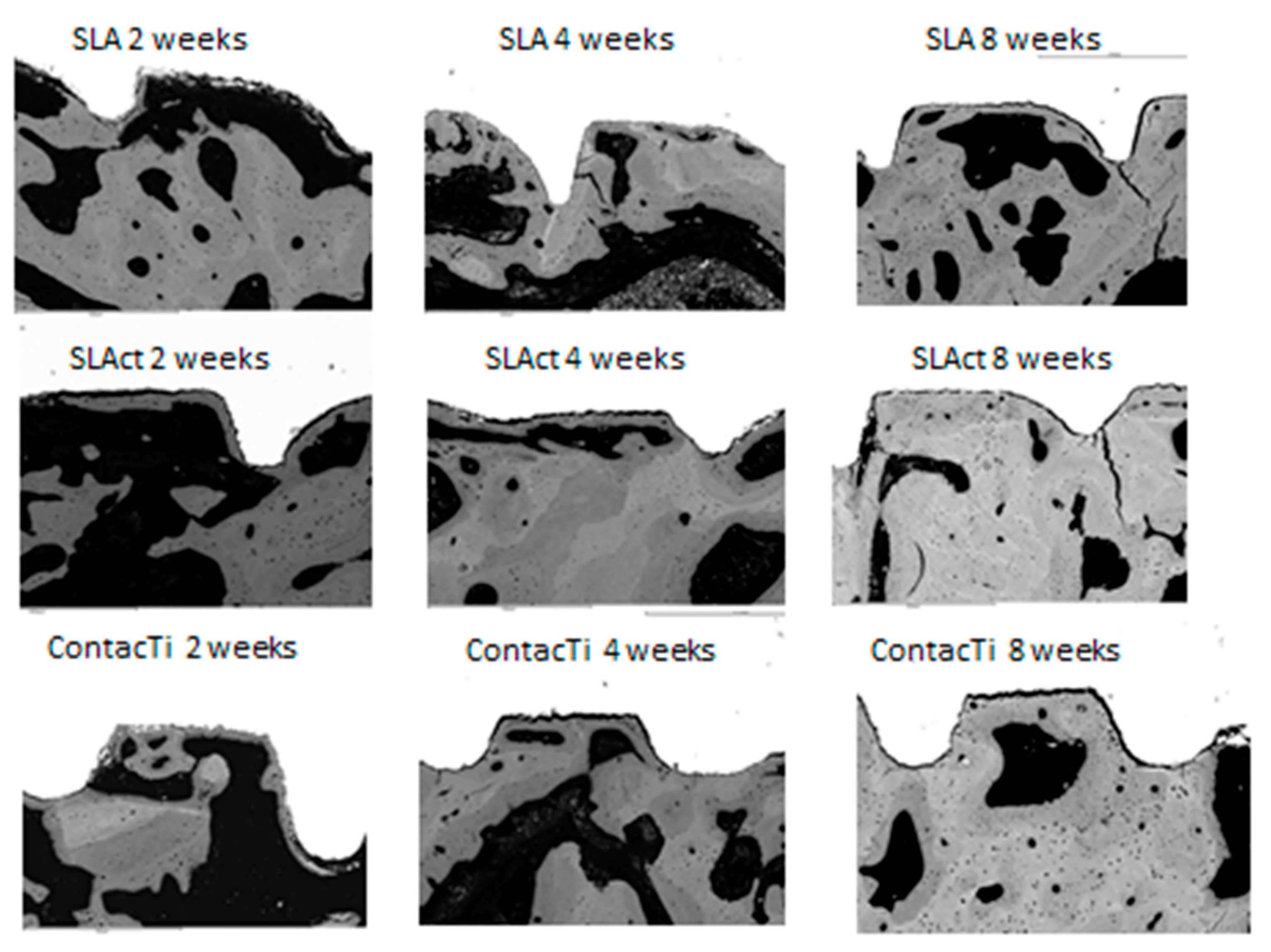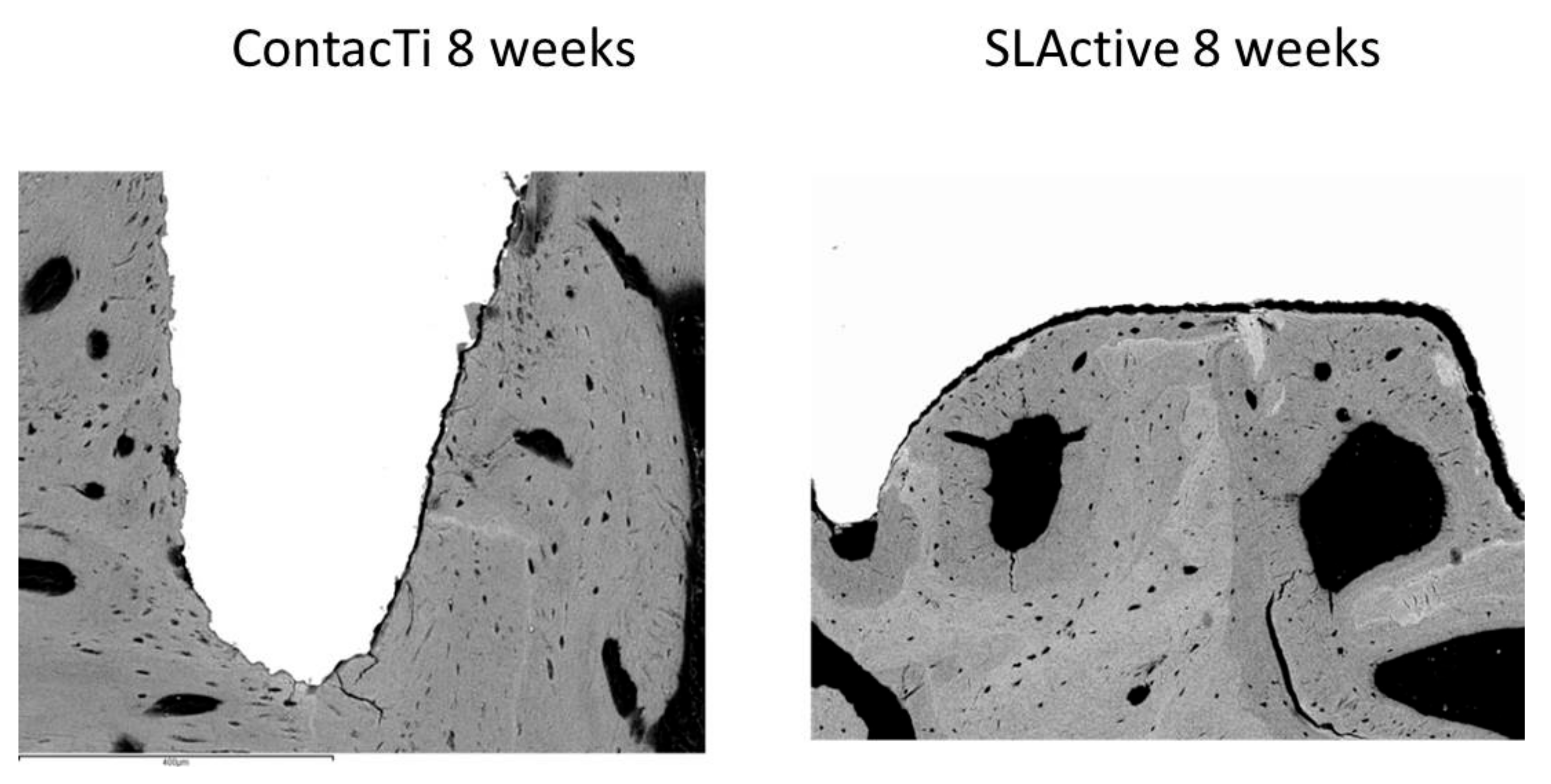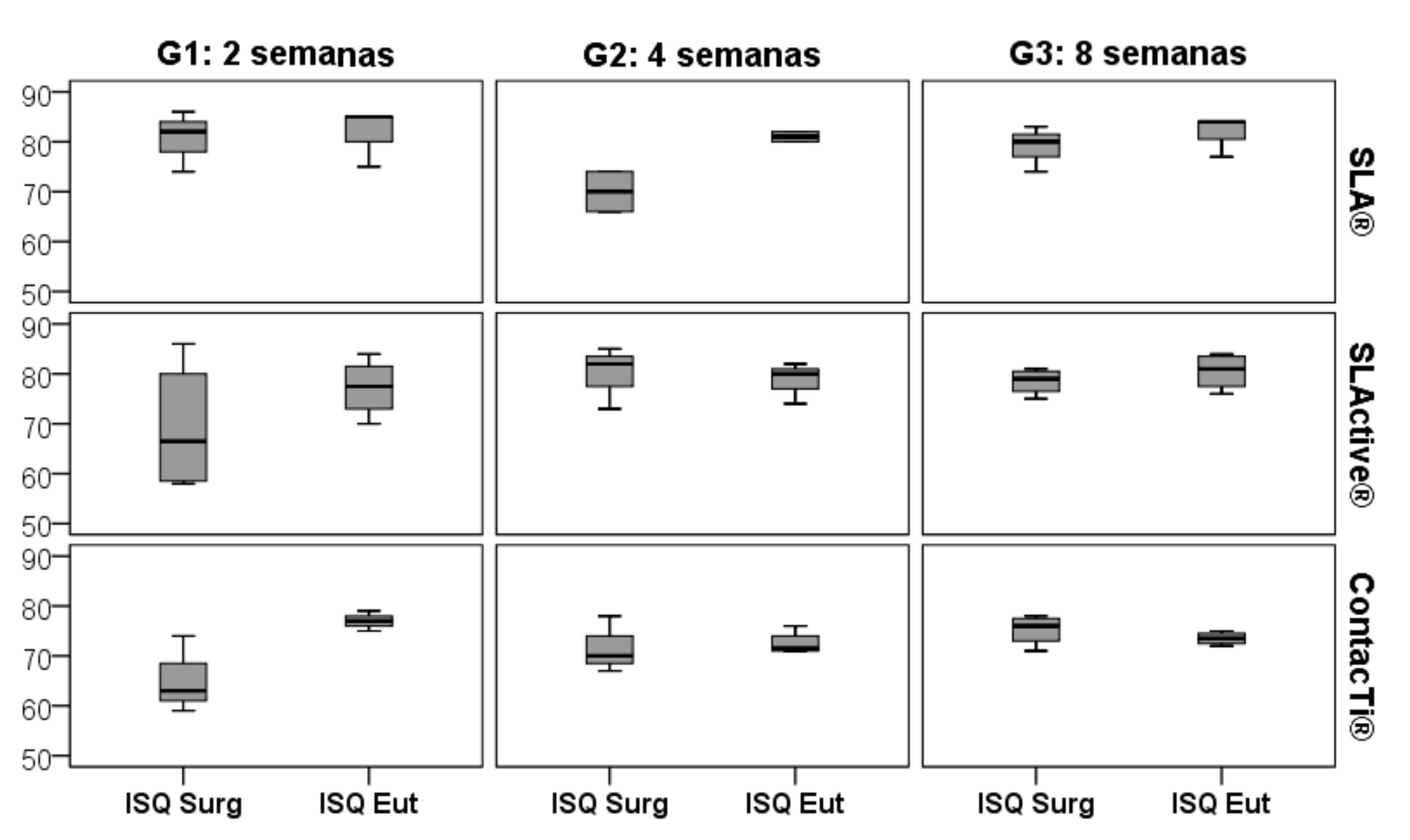Influence of a Novel Surface of Bioactive Implants on Osseointegration: A Comparative and Histomorfometric Correlation and Implant Stability Study in Minipigs
Abstract
1. Introduction
2. Results
2.1. Histological Analysis
2.2. Resonance Frequency Analysis (RFA)
2.3. Bone-Implant Contact (BIC)
2.4. Correlation
3. Discussion
3.1. ISQ and BIC Values for the Three Types of Surfaces
3.2. Correlation between ISQ and %BIC Values
4. Materials and Methods
5. Conclusions
Author Contributions
Funding
Acknowledgments
Conflicts of Interest
References
- Stanford, C.M. Surface modifications of dental implants. Aust. Dent. J. 2008, 53, S26–S33. [Google Scholar] [CrossRef] [PubMed]
- Sennerby, L.; Meredith, N. Implant stability measurements using resonance frequency analysis: biological and biomechanical aspects and clinical implications. Periodontology 2000 2008, 47, 51–66. [Google Scholar] [CrossRef] [PubMed]
- Wennerberg, A.; Jimbo, R.; Stübinger, S.; Obrecht, M.; Dard, M.; Berner, S. Nanostructures and hydrophilicity influence osseointegration: a biomechanical study in the rabbit tibia. Clin. Oral Implant. Res. 2014, 25, 1041–1050. [Google Scholar] [CrossRef] [PubMed]
- Gottlow, J.; Barkarmo, S.; Sennerby, L. An experimental comparison of two different clinically used implant designs and surfaces. Clin. Implant Dent. Relat. Res. 2012, 14, e204–e212. [Google Scholar] [CrossRef]
- Lang, N.P.; Salvi, G.E.; Huynh-Ba, G.; Ivanovski, S.; Donos, N.; Bosshardt, D.D. Early osseointegration to hydrophilic and hydrophobic implant surfaces in humans. Clin. Oral Implant. Res. 2011, 22, 349–356. [Google Scholar] [CrossRef] [PubMed]
- Kokubo, T.; Miyaji, F.; Kim, H.-M.; Nakamura, T. Spontaneous formation of bonelike apatite layer on chemically treated titanium metals. J. Am. Ceram. Soc. 1996, 79, 1127–1129. [Google Scholar] [CrossRef]
- Aparicio, C.; Padrós, A.; Gil, F.-J. In vivo evaluation of micro-rough and bioactive titanium dental implants using histometry and pull-out tests. J. Mech. Behav. Biomed. Mater. 2011, 4, 1672–1682. [Google Scholar] [CrossRef] [PubMed]
- Aparicio, C.; Manero, J.M.; Conde, F.; Pegueroles, M.; Planell, J.A.; Vallet-Regí, M.; Gil, F.J. Acceleration of apatite nucleation on microrough bioactive titanium for bone-replacing implants. J. Biomed. Mater. Res. Part A 2007, 82A, 521–529. [Google Scholar] [CrossRef] [PubMed]
- Gil, F.J.; Padrós, A.; Manero, J.M.; Aparicio, C.; Nilsson, M.; Planell, J.A. Growth of bioactive surfaces on titanium and its alloys for orthopaedic and dental implants. Mater. Sci. Eng. C 2002, 22, 53–60. [Google Scholar] [CrossRef]
- Meredith, N.; Alleyne, D.; Cawley, P. Quantitative determination of the stability of the implant-tissue interface using resonance frequency analysis. Clin. Oral Implant. Res. 1996, 7, 261–267. [Google Scholar] [CrossRef]
- Glauser, R.; Sennerby, L.; Meredith, N.; Ree, A.; Lundgren, A.; Gottlow, J.; Hammerle, C.H.F. Resonance frequency analysis of implants subjected to immediate or early functional occlusal loading. Successful vs. failing implants. Clin. Oral Implant. Res. 2004, 15, 428–434. [Google Scholar] [CrossRef] [PubMed]
- Balshi, S.F.; Allen, F.D.; Wolfinger, G.J.; Balshi, T.J. A resonance frequency analysis assessment of maxillary and mandibular immediately loaded implants. Int. J. Oral Maxillofac. Implant. 2005, 20, 584–594. [Google Scholar]
- Brizuela-Velasco, A.; Álvarez-Arenal, Á.; Gil-Mur, F.J.; Herrero-Climent, M.; Chávarri-Prado, D.; Chento-Valiente, Y.; Dieguez-Pereira, M. Relationship between insertion torque and resonance frequency measurements, performed by resonance frequency analysis, in micromobility of dental implants. Implant. Dent. 2015, 24, 607–611. [Google Scholar] [CrossRef] [PubMed]
- Becker, W.; Sennerby, L.; Bedrossian, E.; Becker, B.E.; Lucchini, J.P. Implant stability measurements for implants placed at the time of extraction: A cohort, prospective clinical trial. J. Periodontol. 2005, 76, 391–397. [Google Scholar] [CrossRef]
- De Smet, E.; Jaecques, S.; Vandamme, K.; Vander Sloten, J.; Naert, I. Positive effect of early loading on implant stability in the bi-cortical guinea-pig model. Clin. Oral Implant. Res. 2005, 16, 402–407. [Google Scholar] [CrossRef]
- Schliephake, H.; Sewing, A.; Aref, A. Resonance frequency measurements of implant stability in the dog mandible: Experimental comparison with histomorphometric data. Int. J. Oral Maxillofac. Surg. 2006, 35, 941–946. [Google Scholar] [CrossRef] [PubMed]
- Ito, Y.; Sato, D.; Yoneda, S.; Ito, D.; Kondo, H.; Kasugai, S. Relevance of resonance frequency analysis to evaluate dental implant stability: Simulation and histomorphometrical animal experiments. Clin. Oral Implant. Res. 2008, 19, 9–14. [Google Scholar] [CrossRef] [PubMed]
- Rocci, A.; Martignoni, M.; Burgos, P.M.; Gottlow, J.; Sennerby, L. Histology of retrieved immediately and early loaded oxidized implants: Light microscopic observations after 5 to 9 months of loading in the posterior mandible. Clin. Implant Dent. Relat. Res. 2003, 5, 88–98. [Google Scholar] [CrossRef] [PubMed]
- Gedrange, T.; Hietschold, V.; Mai, R.; Wolf, P.; Nicklisch, M.; Harzer, W. An evaluation of resonance frequency analysis for the determination of the primary stability of orthodontic palatal implants. A study in human cadavers. Clin. Oral Implant. Res. 2005, 16, 425–431. [Google Scholar] [CrossRef] [PubMed]
- Nkenke, E.; Hahn, M.; Weinzierl, K.; Radespiel-Troger, M.; Neukam, F.W.; Engelke, K. Implant stability and histomorphometry: A correlation study in human cadavers using stepped cylinder implants. Clin. Oral Implant. Res. 2003, 14, 601–609. [Google Scholar] [CrossRef]
- Rabel, A.; Köhler, S.G.; Schmidt-Westhausen, A.M. Clinical study on the primary stability of two dental implant systems with resonance frequency analysis. Clin. Oral Investig. 2007, 11, 257–265. [Google Scholar] [CrossRef]
- Sennerby, L.; Persson, L.G.; Berglundh, T.; Wennerberg, A.; Lindhe, J. Implant stability during initiation and resolution of experimental periimplantitis: An experimental study in the dog. Clin. Implant Dent. Relat. Res. 2005, 7, 136–140. [Google Scholar] [CrossRef]
- Davies, J.E. Mechanisms of endosseous integration. Int. J. Prosthodont. 1998, 11, 391–401. [Google Scholar] [PubMed]
- Strnad, J.; Urban, K.; Povysil, C.; Strnad, Z. Secondary stability assessment of titanium implants with an alkali-etched surface: A resonance frequency analysis study in beagle dogs. Int. J. Oral Maxillofac. Implant. 2008, 23, 502–512. [Google Scholar]
- Thomas, K.A.; Cook, S.D. An evaluation of variables influencing implant fixation by direct bone apposition. J. Biomed. Mater. Res. 1985, 19, 875–901. [Google Scholar] [CrossRef] [PubMed]
- Lamers, E.; Walboomers, X.F.; Domanski, M.; Te Riet, J.; van Delft, F.C.M.J.M.; Luttge, R.; Winnubst, L.A.J.A.; Gardeniers, H.J.G.E.; Jansen, J.A. The influence of nanoscale grooved substrates on osteoblast behavior and extracellular matrix deposition. Biomaterials 2010, 31, 3307–3316. [Google Scholar] [CrossRef]
- Wennerberg, A.; Hallgren, C.; Johansson, C.; Danelli, S. A histomorphometric evaluation of screw-shaped implants each prepared with two surface roughnesses. Clin. Oral Implant. Res. 1998, 9, 11–19. [Google Scholar] [CrossRef]
- Buser, D.; Schenk, R.K.; Steinemann, S.; Fiorellini, J.P.; Fox, C.H.; Stich, H. Influence of surface characteristics on bone integration of titanium implants. A histomorphometric study in miniature pigs. J. Biomed. Mater. Res. 1991, 25, 889–902. [Google Scholar] [CrossRef]
- Buser, D.; Broggini, N.; Wieland, M.; Schenk, R.K.; Denzer, A.J.; Cochran, D.L.; Hoffmann, B.; Lussi, A.; Steinemann, S.G. Enhanced bone apposition to a chemically modified SLA titanium surface. J. Dent. Res. 2004, 83, 529–533. [Google Scholar] [CrossRef]
- Gil, F.J.; Manzanares, N.; Badet, A.; Aparicio, C.; Ginebra, M.-P. Biomimetic treatment on dental implants for short-term bone regeneration. Clin. Oral Investig. 2014, 18, 59–66. [Google Scholar] [CrossRef]
- Meredith, N.; Shagaldi, F.; Alleyne, D.; Sennerby, L.; Cawley, P. The application of resonance frequency measurements to study the stability of titanium implants during healing in the rabbit tibia. Clin. Oral Implant. Res. 1997, 8, 234–243. [Google Scholar] [CrossRef]
- Scarano, A.; Degidi, M.; Iezzi, G.; Petrone, G.; Piattelli, A. Correlation between implant stability quotient and bone-implant contact: A retrospective histological and histomorphometrical study of seven titanium implants retrieved from humans. Clin. Implant Dent. Relat. Res. 2006, 8, 218–222. [Google Scholar] [CrossRef]
- Huwiler, M.A.; Pjetursson, B.E.; Bosshardt, D.D.; Salvi, G.E.; Lang, N.P. Resonance frequency analysis in relation to jawbone characteristics and during early healing of implant installation. Clin. Oral Implant. Res. 2007, 18, 275–280. [Google Scholar] [CrossRef] [PubMed]
- Abrahamsson, I.; Linder, E.; Lang, N.P. Implant stability in relation to osseointegration: An experimental study in the Labrador dog. Clin. Oral Implant. Res. 2009, 20, 313–318. [Google Scholar] [CrossRef]
- Degidi, M.; Perrotti, V.; Piattelli, A.; Iezzi, G. Mineralized bone-implant contact and implant stability quotient in 16 human implants retrieved after early healing periods: A histologic and histomorphometric evaluation. Int. J. Oral Maxillofac. Implant. 2009, 25, 45–48. [Google Scholar]
- Jun, S.H.; Chang, B.M.; Weber, H.P.; Kwon, J.J. Comparison of initial stability parameters and histomorphometric analysis of implants inserted into extraction sockets: Human fresh cadaver study. Int. J. Oral Maxillofac. Implant. 2010, 25, 985–990. [Google Scholar]
- Stadlinger, B.; Bierbaum, S.; Grimmer, S.; Schulz, M.C.; Kuhlisch, E.; Scharnweber, D.; Eckelt, U.; Mai, R. Increased bone formation around coated implants. J. Clin. Periodontol. 2009, 36, 698–704. [Google Scholar] [CrossRef]
- Blanco, J.; Alvarez, E.; Muñoz, F.; Liñares, A.; Cantalapiedra, A. Influence on early osseointegration of dental implants installed with two different drilling protocols: A histomorphometric study in rabbit. Clin. Oral Implant. Res. 2011, 22, 92–99. [Google Scholar] [CrossRef]
- Abdel-Haq, J.; Karabuda, C.Z.; Arisan, V.; Mutlu, Z.; Kürkçü, M. Osseointegration and stability of a modified sand-blasted acid-etched implant: An experimental pilot study in sheep. Clin. Oral Implant. Res. 2011, 22, 265–274. [Google Scholar] [CrossRef] [PubMed]
- Park, J.-W.; Kwon, T.-G.; Suh, J.-Y. The relative effect of surface strontium chemistry and super-hydrophilicity on the early osseointegration of moderately rough titanium surface in the rabbit femur. Clin. Oral Implant. Res. 2013, 24, 706–709. [Google Scholar] [CrossRef]
- Manresa, C.; Bosch, M.; Echeverría, J.J. The comparison between implant stability quotient and bone-implant contact revisited: An experiment in Beagle dog. Clin. Oral Implant. Res. 2014, 25, 1213–1221. [Google Scholar] [CrossRef]
- Dagher, M.; Mokbel, N.; Jabbour, G.; Naaman, N. Resonance frequency analysis, insertion torque, and bone to implant contact of 4 implant surfaces: Comparison and correlation study in sheep. Implant Dent. 2014, 23, 672–678. [Google Scholar] [CrossRef] [PubMed]
- Soares, P.B.F.; Moura, C.C.G.; Claudino, M.; Carvalho, V.F.; Rocha, F.S.; Zanetta-Barbosa, D. Influence of implant surfaces on osseointegration: A histomorphometric and implant stability study in rabbits. Braz. Dent. J. 2015, 26, 451–457. [Google Scholar] [CrossRef] [PubMed]
- Acil, Y.; Sievers, J.; Gülses, A.; Ayna, M.; Wiltfang, J.; Terheyden, H. Correlation between resonance frequency, insertion torque and bone-implant contact in self-cutting threaded implants. Odontology 2017, 105, 347–353. [Google Scholar] [CrossRef]
- Gehrke, S.A.; de Val, J.E.M.S.; Domínguez, M.F.; Moya, P.N.D.A.; Moreno, G.G.; Guirado, J.L.C. Effects on the osseointegration of titanium implants incorporating calcium-magnesium: A resonance frequency and histomorphometric analysis in rabbit tibia. Clin. Oral Implant. Res. 2018, 29, 785–791. [Google Scholar] [CrossRef] [PubMed]
- Chang, Y.-C.; Ho, K.-N.; Feng, S.-W.; Huang, H.-M.; Chang, C.-H.; Lin, C.-T.; Teng, N.-C.; Pan, Y.H.; Chang, W.-J. Fibronectin-grafted titanium dental implants: An in vivo study. BioMed. Res. Int. 2016, 2016, 1–11. [Google Scholar] [CrossRef][Green Version]
- Rasmusson, L.; Kahnberg, K.-E.; Tan, A. Effects of implant design and surface on bone regeneration and implant stability: An experimental study in the Dog Mandible. Clin. Implant Dent. Relat. Res. 2001, 3, 2–8. [Google Scholar] [CrossRef]
- Friberg, B.; Sennerby, L.; Meredith, N.; Lekholm, U. A comparison between cutting torque and resonance frequency measurements of maxillary implants. A 20-month clinical study. Int. J. Oral Maxillofac. Surg. 1999, 28, 297–303. [Google Scholar] [CrossRef]
- Hsu, J.T.; Huang, H.L.; Tsai, M.T.; Wu, A.Y.J.; Tu, M.G.; Fuh, L.J. Effects of the 3D bone-to-implant contact and bone stiffness on the initial stability of a dental implant: Micro-CT and resonance frequency analyses. Int. J. Oral Maxillofac. Surg. 2013, 42, 276–280. [Google Scholar] [CrossRef] [PubMed]
- Buser, D.; Nydegger, T.; Oxland, T.; Cochran, D.L.; Schenk, R.K.; Hirt, H.P.; Snetivy, D.; Nolte, L.-P. Interface shear strength of titanium implants with a sandblasted and acid-etched surface: A biomechanical study in the maxilla of miniature pigs. J. Biomed. Mater. Res. 1999, 45, 75–83. [Google Scholar] [CrossRef]
- Germanier, Y.; Tosatti, S.; Broggini, N.; Textor, M.; Buser, D. Enhanced bone apposition around biofunctionalized sandblasted and acid-etched titanium implant surfaces. A histomorphometric study in miniature pigs. Clin. Oral Implant. Res. 2006, 17, 251–257. [Google Scholar] [CrossRef] [PubMed]
- Donath, K.; Breuner, G. A method for the study of undecalcified bones and teeth with attached soft tissues. The Sage-Schliff (sawing and grinding) technique. J. Oral Pathol. Med. 1982, 11, 318–326. [Google Scholar] [CrossRef]




| GROUP 1 | ISQ SURG | ISQ EUT (2 Weeks) | ||
|---|---|---|---|---|
| N | Mean ± SD | N | Mean ± SD | |
| SLA® | 4 | 81.25 ± 5.12 | 3 | 81.67 ± 5.77 |
| SLActive® | 4 | 69.25 ± 13.35 | 4 | 77.25 ± 5.85 |
| ContacTi® | 3 | 65.33 ± 7.77 | 3 | 77.00 ± 2.00 |
| p | 0.124 | 0.467 | ||
| GROUP 2 | ISQ SURG | ISQ EUT (4 Weeks) | ||
|---|---|---|---|---|
| N | Mean ± SD | N | Mean ± SD | |
| SLA® | 4 | 68.00B ± 4.69 | 2 | 81.00a ± 1.41 |
| SLActive® | 4 | 76.00 ± 9.49 | 3 | 78.67ab ± 4.16 |
| ContacTi® | 4 | 71.25 ± 4.72 | 4 | 72.50bB ± 2.38 |
| p | 0.285 | 0.030 | ||
| GROUP 3 | ISQ SURG | ISQ EUT (8 Weeks) | ||
|---|---|---|---|---|
| N | Mean ± SD | N | Mean ± SD | |
| SLA® | 4 | 79.25A ± 3.77 | 3 | 81.67a ± 4.04 |
| SLActive® | 4 | 78.50 ± 2.65 | 4 | 80.50a ± 3.70 |
| ContacTi® | 4 | 75.25 ± 3.10 | 4 | 73.50bAB ± 1.29 |
| p | 0.226 | 0.015 | ||
| BIC (%) | Group 1: EUT at 2 Weeks | Group 2: EUT at 4 Weeks | Group 3: EUT at 8 Weeks | p | |||
|---|---|---|---|---|---|---|---|
| N | Mean ± SD | N | Mean ± SD | N | Mean ± SD | ||
| SLA® | 8 | 53.56B ± 19.96 | 6 | 81.60A ± 13.31 | 8 | 77.99bA ± 6.89 | 0.003 |
| SLActive® | 8 | 61.56B ± 13.39 | 8 | 85.36A ± 13.98 | 8 | 87.18aA ± 4.93 | <0.001 |
| ContacTi® | 6 | 62.35B ± 20.01 | 8 | 88.25A ± 17.67 | 8 | 90.0258abA ± 9.90 | <0.001 |
| p | 0.493 | 0.847 | 0.020 | ||||
| G1: 2 Weeks | G2: 4 Weeks | G3: 8 Weeks | G1: 2 Weeks | G2: 4 Weeks | G3: 8 Weeks | ||
|---|---|---|---|---|---|---|---|
| Surface | ISQ Eut vs. BIC (%) | ISQ Eut vs. BAT (%) | |||||
| SLA® | Spearman’s rho | 0.828 | 0.943 | 0.000 | 0.828 | 0.894 | −0.621 |
| p | 0.052 | 0.057 | 1.000 | 0.052 | 0.106 | 0.188 | |
| N | 6 | 4 | 6 | 6 | 4 | 6 | |
| SLActive® | Spearman’s rho | 0.683 | 0.956 | −0.146 | 0.634 | −0.598 | −0.537 |
| p | 0.062 | 0.053 | 0.729 | 0.091 | 0.210 | 0.170 | |
| N | 8 | 6 | 8 | 8 | 6 | 8 | |
| ContacTi® | Spearman’s rho | −0.717 | −0.206 | 0.244 | −0.478 | −0.466 | −0.098 |
| p | 0.109 | 0.625 | 0.560 | 0.338 | 0.245 | 0.818 | |
| N | 6 | 8 | 8 | 6 | 8 | 8 | |
© 2019 by the authors. Licensee MDPI, Basel, Switzerland. This article is an open access article distributed under the terms and conditions of the Creative Commons Attribution (CC BY) license (http://creativecommons.org/licenses/by/4.0/).
Share and Cite
Romero-Ruiz, M.M.; Gil-Mur, F.J.; Ríos-Santos, J.V.; Lázaro-Calvo, P.; Ríos-Carrasco, B.; Herrero-Climent, M. Influence of a Novel Surface of Bioactive Implants on Osseointegration: A Comparative and Histomorfometric Correlation and Implant Stability Study in Minipigs. Int. J. Mol. Sci. 2019, 20, 2307. https://doi.org/10.3390/ijms20092307
Romero-Ruiz MM, Gil-Mur FJ, Ríos-Santos JV, Lázaro-Calvo P, Ríos-Carrasco B, Herrero-Climent M. Influence of a Novel Surface of Bioactive Implants on Osseointegration: A Comparative and Histomorfometric Correlation and Implant Stability Study in Minipigs. International Journal of Molecular Sciences. 2019; 20(9):2307. https://doi.org/10.3390/ijms20092307
Chicago/Turabian StyleRomero-Ruiz, Manuel M., Francisco Javier Gil-Mur, José Vicente Ríos-Santos, Pedro Lázaro-Calvo, Blanca Ríos-Carrasco, and Mariano Herrero-Climent. 2019. "Influence of a Novel Surface of Bioactive Implants on Osseointegration: A Comparative and Histomorfometric Correlation and Implant Stability Study in Minipigs" International Journal of Molecular Sciences 20, no. 9: 2307. https://doi.org/10.3390/ijms20092307
APA StyleRomero-Ruiz, M. M., Gil-Mur, F. J., Ríos-Santos, J. V., Lázaro-Calvo, P., Ríos-Carrasco, B., & Herrero-Climent, M. (2019). Influence of a Novel Surface of Bioactive Implants on Osseointegration: A Comparative and Histomorfometric Correlation and Implant Stability Study in Minipigs. International Journal of Molecular Sciences, 20(9), 2307. https://doi.org/10.3390/ijms20092307









